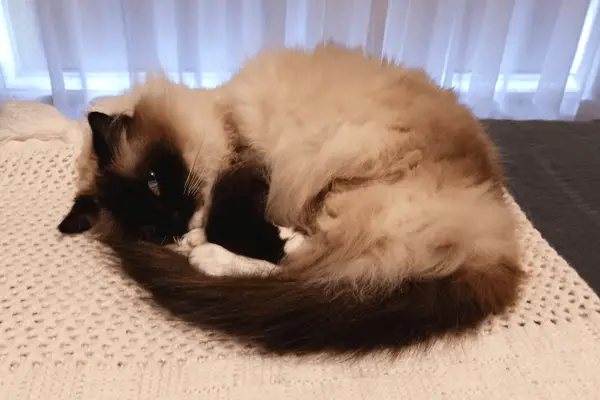Ragdoll cats are instantly recognisable for their long, fluffy coats, blue eyes, distinctive facial markings and affectionate, loving personalities.
For this reason, some people make the mistake of shaving their ragdolls in the summer to try and keep them cool – even though they regulate body temperature just fine on their own.
But what about during winter? Given their physical characteristics, one question you may have is: do ragdoll cats get cold?
Yes, ragdoll cats feel the cold and are susceptible to chilly temperatures. Unlike wild cats, ragdolls are domesticated and have grown used to living indoors where the climate is dry and warm. If you left a ragdoll cat outside in the elements, especially during winter, they would certainly feel cold.
What you’ll notice when owning a ragdoll cat is their coat will actually thicken and fill out during the colder months to help keep them warmer, before shedding when it gets hotter.
Keep reading to find out more about how ragdoll cats handle the cold weather.
How ragdoll cats’ physical characteristics help combat the cold
The ragdoll cat’s thick hair is its main defence against cold temperatures and helps to retain body warmth. In chilly weather, it’s often why you’ll see ragdolls curled up in a ball, usually in the warmest place in the house – such as the end of your bed or in front of windows with sunlight beaming in.
While ragdolls aren’t particularly active, many people mistake this as laziness – when in fact, it’s how they conserve energy and helps them regulate their body heat.
But despite their natural defences against the cold, ragdoll cats – like other animals and even humans – will struggle when the mercury drops to near freezing levels.
Below are answers to some common questions you may have about ragdolls and the cold.
Do ragdoll cats get cold easily?
While ragdoll cats may be able to withstand the cold better than other breeds due to their longer hair, they can certainly get uncomfortably chilly if the temperature drops far enough. The susceptibility of ragdolls to cold weather can vary based on several factors, including their age, health, and overall physical condition.
However, as a general rule, ragdoll cats do not handle cold temperatures well and can get cold easily.
Additionally, they have a thinner layer of fat and muscle than some bigger cats might have, such as Maine Coons, which makes it harder for them to generate and maintain their body heat.
How cold is too cold for ragdoll cats?
The ideal temperature range for ragdoll cats is between 68 to 75 degrees Fahrenheit (20 to 24 degrees Celsius). Temperatures below 50 degrees Fahrenheit (10 degrees Celsius) may be too cold for them and can lead to health issues like hypothermia, which is a dangerous drop in body temperature.
You should ensure that the temperature in your home or apartment is comfortable for your ragdoll cat, especially during the colder months.
If you live in a colder climate year-round, you may need to provide additional heating sources, such as a space heater or heated cat bed, to guarantee your ragdoll stays warm, cosy and healthy.
Do ragdoll cats like warm weather?
Yes, ragdoll cats enjoy warm weather provided the heat isn’t extreme (above 100 degrees Fahrenheit or 38 degrees Celsius). Ragdolls will often seek out sunny spots around the house or warm blankets to lounge in to stay comfortable.
It’s not unusual for my wife or I to come home and find our cat Poppie curled up on the blanket at the end of our bed, or inside her scratching tree – which is also lined with warm, fluffy fabric.
When summer hits, ragdolls will start to shed their winter coat (usually around their neck and chest) to help regulate their temperature better.
This is why there’s no need to shave their fur, as their body will drop hair naturally until it reaches a point where it’s comfortable.
Can ragdoll cats be left outside?
It’s not recommended to leave ragdoll cats outside for two reasons. Firstly, they’re not equipped to handle the elements and are vulnerable to predators and other dangers. Secondly, they’re a loyal and affectionate breed that thrives on human interaction, and being outside for extended periods of time can lead to loneliness and anxiety.
Leaving ragdolls outside to fend for themselves can be life-threatening for them, especially if you haven’t enclosed your yard properly and they manage to escape into the wild.
However, that’s not to say they can’t do so under supervision – we’ll often let our ragdoll Poppie into the backyard, as she loves chasing bugs, watching birds and chewing grass.
But, when we decide it’s time to go inside, we certainly don’t leave her out there alone, and you probably should do likewise with your own cat.
Ultimately, the best place for a ragdoll cat is inside, in a warm and cosy spot, where they can receive plenty of love and attention from their owners.
Do ragdoll cats have winter coats?
Yes, they do. Ragdoll cats, like many other animals, have a natural process of shedding and growing their coat that is influenced by changes in the seasons. In the winter, when the weather is colder, ragdolls’ coats get thicker to help them retain heat and stay warm. The increased thickness of their fur is a result of the hair follicles becoming more active and producing more hair.
By contrast, in the summer months when the weather is warmer, ragdolls’ coats begin to shed.
This process is a natural way for their body to regulate their temperature by removing the excess fur and allowing for more airflow through their coat.
Despite ragdolls shedding their coat in the summer, they still have a soft and fluffy coat year-round.
Regular grooming is essential for preventing matting while this occurs, as brushing their fur helps to remove loose hair and prevent hairballs, which can be a common issue for cats that shed heavily.
Final message
Despite their fluffy and warm appearances, ragdoll cats are a domestic breed that don’t handle cold temperatures very well and aren’t well equipped for life outdoors in the elements.
This is particularly the case in the winter, when the weather can drop below freezing overnight.
Keeping your ragdoll indoors, in a warm and cosy spot, is the best way to ensure they stay healthy and happy.

